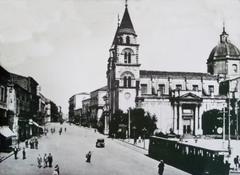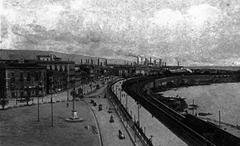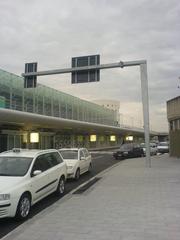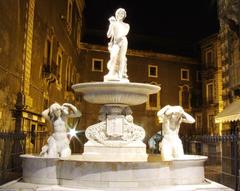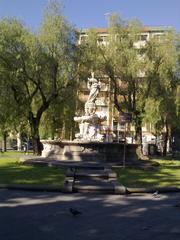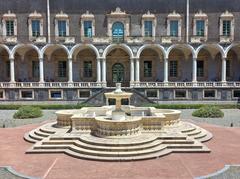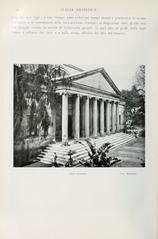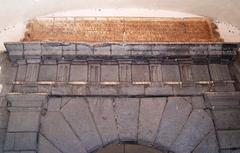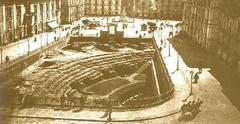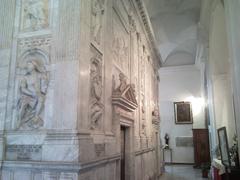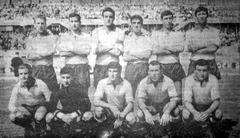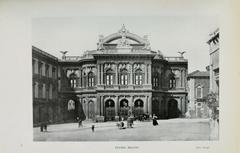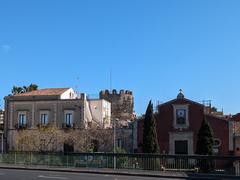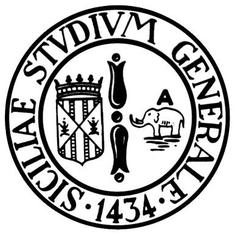Arch of San Giovanni: Visiting Hours, Tickets, and Historical Significance in Catania, Italy
Date: 14/06/2025
Introduction
Nestled in the heart of Catania, Sicily, the Arch of San Giovanni (Arco di San Giovanni) stands as a testament to the city’s layered history, resilience, and unique Baroque identity. This comprehensive guide explores the monument’s origins, architectural features, cultural importance, and practical visitor information. Whether you’re a history enthusiast or a curious traveler, you’ll find everything needed to experience this emblematic site and understand its place in Catania’s vibrant urban fabric (Britannica; Wonders of Sicily).
Table of Contents
- Historical Context and Urban Evolution
- Architectural Features and Baroque Influence
- Religious and Cultural Significance
- Visitor Information: Hours, Tickets, and Accessibility
- Safety Tips and Travel Recommendations
- Nearby Attractions and Suggested Itineraries
- Events and Festivals
- Guided Tours and Virtual Resources
- Frequently Asked Questions (FAQ)
- Visual Enhancements and Photography Tips
- Sustainability and Responsible Tourism
- Summary and Call to Action
- References
Historical Context and Urban Evolution
Catania’s strategic position on Sicily’s eastern coast has attracted Greeks, Romans, Byzantines, Arabs, Normans, and Spaniards over the centuries, each contributing to the city’s cultural and architectural tapestry (Britannica). The San Giovanni area, where the arch stands, witnessed dramatic transformations, particularly after the 1669 eruption of Mount Etna and the catastrophic earthquake of 1693. These disasters destroyed much of the medieval city, prompting a Baroque reconstruction led by architects such as Giovanni Battista Vaccarini (Italian Art Society).
The Arch of San Giovanni, constructed during this period, functioned as a ceremonial city gate and a threshold between sacred and secular spaces. Its presence illustrates how Catania’s urban design seamlessly blends its ancient, medieval, and Baroque layers (The Sane Travel).
Architectural Features and Baroque Influence
Baroque Design and Materials
The arch exemplifies Sicilian Baroque style, characterized by expressive curves, ornate ornamentation, and the interplay of light and shadow (The Design Gesture). Constructed from locally sourced black lava stone—a signature of Catania—its dark hues contrast strikingly with lighter limestone details (Great Sicily). The monument’s decorative elements include sculpted coats of arms, religious motifs, and intricate cornices, reflecting both defensive and ceremonial functions.
Urban Integration
Aligned with key Baroque thoroughfares like Via dei Crociferi, the arch not only punctuates the cityscape but also connects visitors to nearby landmarks such as the Cathedral of Sant’Agata and the Benedictine Monastery of San Nicolò l’Arena (The Crave Traveler).
Religious and Cultural Significance
The Arch of San Giovanni is deeply intertwined with Catania’s religious life, particularly the veneration of St. Agatha, the city’s patron saint. During annual festivities like the Festa di Sant’Agata, the arch forms part of the processional route, serving as a symbolic passage between spiritual and civic life (Go Ask a Local). The arch’s enduring presence after repeated disasters embodies Catania’s motto: “Melior de cinere surgo” (“I rise again from the ashes”) (Wonders of Sicily).
Visitor Information: Hours, Tickets, and Accessibility
Hours and Tickets
- Open 24/7: As an outdoor monument, the Arch of San Giovanni is accessible at all hours, year-round.
- No Entry Fee: There are no tickets or entry charges required for visiting the arch.
Accessibility
- Pedestrian-Friendly: The site is easily reached on foot from central landmarks such as Piazza del Duomo and Via Etnea (MapTurners).
- Public Transport: Bus routes and the Catania Centrale railway station are nearby.
- For Visitors with Disabilities: Most main routes are accessible, though some cobbled or narrow streets may pose minor challenges. Contact the local tourist office for detailed assistance (Traveling Italian).
Safety Tips and Travel Recommendations
- General Safety: Catania’s historic center is generally safe, but keep an eye on your belongings and be cautious in crowded areas (Sacavoyage).
- Traffic Awareness: Be mindful of scooters and local traffic, especially on side streets.
- Respectful Behavior: Do not climb or deface the monument; fines may apply.
Nearby Attractions and Suggested Itineraries
- Benedictine Monastery of San Nicolò l’Arena: One of Europe’s largest monasteries (The Crave Traveler).
- Via dei Crociferi: UNESCO-listed street famed for Baroque churches.
- Roman Theatre and Odeon: Ancient ruins nearby, with entry fees (Italien Entdecken).
- Giardini Bellini: Historic urban park, ideal for relaxation.
- La Pescheria Market: Traditional Sicilian fish market for authentic local life.
Tourist maps are available at Piazza del Duomo and main historic center entrances.
Events and Festivals
- Festa di Sant’Agata (February): Major religious festival with processions, impacting foot traffic and street access near the arch (Untold Italy). Visiting during these times offers a unique cultural experience but may require additional planning.
Guided Tours and Virtual Resources
- Walking Tours: Many operators include the arch in guided explorations of Catania’s Baroque district. Tours last 2–3 hours and are available in English and Italian, typically costing €10–€25 (Guide Catania).
- Virtual Tours and Maps: Interactive resources and virtual experiences are available through local tourism websites and apps.
Frequently Asked Questions (FAQ)
Q: What are the Arch of San Giovanni visiting hours?
A: The arch is accessible 24 hours a day, every day.
Q: Is there an entry fee or ticket?
A: No, visiting the Arch of San Giovanni is free.
Q: Are guided tours available?
A: Yes, many walking tours include the arch and can be booked ahead.
Q: How do I get there?
A: The arch is centrally located, accessible by foot, bus, or car.
Q: Is the site accessible for visitors with disabilities?
A: Main routes are mostly accessible, but some uneven surfaces may be present.
Q: What should I bring?
A: Comfortable shoes, sun protection, water, camera, and light clothing.
Visual Enhancements and Photography Tips
- Best Light: Early morning and late afternoon provide optimal natural light for capturing the arch’s details.
- Photography: Drones generally require special permits and are not allowed in the historic center.
- Alt Text for Images: Use descriptive phrases such as “Arch of San Giovanni Baroque monument in Catania historic center.”
Sustainability and Responsible Tourism
Support Catania’s heritage by respecting the monument, disposing of litter properly, and supporting local businesses. Many tours promote sustainable tourism practices.
Summary and Call to Action
The Arch of San Giovanni is a vital emblem of Catania’s Baroque heritage and enduring spirit, freely accessible and woven into the heart of the city’s historical district. A visit offers not only insight into centuries of resilience and artistry but also an entry point to the surrounding UNESCO-listed streets, religious festivals, and vibrant urban life (Britannica; Italian Art Society). For a richer experience, leverage modern resources such as the Audiala app for guided tours, maps, and local insights.
Ready to explore?
- Download the Audiala app for interactive guides and up-to-date travel tips.
- Follow us on social media and subscribe to our newsletter for the latest updates, event information, and cultural highlights.
References
- Catania - Britannica
- Wonders of Sicily
- The Design Gesture
- Italian Art Society
- The Crave Traveler
- Guide Catania
- MapTurners
- Great Sicily
- GPSmyCity Walking Tours
- Italien Entdecken
- Untold Italy
- Traveling Italian
- The Sane Travel
- Go Ask a Local
- Sacavoyage
